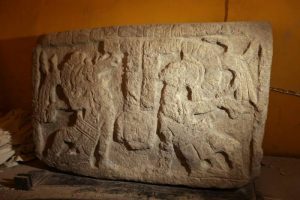An original Mayan piece dating from the late Classic period (600-900 AD) and that since 1954 was in an old building of the Historical Center of Merida, that operated as a hotel for many years, was recovered Tuesday Dec. 6 by the National Institute of Anthropology and History (INAH), delegation of Yucatan.
The stone glyph will be displayed temporarily at the Palacio Cantón Museum in Merida before being returned to the hotel owners, according to a news report on sipse.com.
According to the INAH report, the “archaeological monument” called the Ichmul panel and which for decades was displayed inside the then-Hotel Mérida Mission, was always considered a simple replica without much commercial value, but its authenticity places it as a historic asset of the nation and of incalculable value.
The owners of the property, for months in the process of restoration after years of abandonment, notified the federal agency so that their experts could determine if the piece was original. It turned out to be authentic and currently becomes part of the national patrimony with the number 2755 P.M.1 of Folio Real 1AMA00141331 of the Register of Monuments and Archaeological and Historical Areas of INAH.
The stone is officially called Ichmul Panel 1, corresponding to a carved and sculpted limestone of dimensions of 87cm x 133cm x 42cm.
The diligence was carried out by various specialists of the INAH in the state and was symbolically handed over by the hotel owners to José Arturo Chab Cárdenas, Head of Procedures and Legal Services of INAH in Yucatán.
According to the INAH, this archaeological property is the nation’s full, inalienable and imprescriptible property and comes from the archaeological site called Ichmul de Morley, an archaeological site reported by the American archaeologist Sylvanus G. Morley in 1919 through a tour he carried out to identify hieroglyphs of the region. The explorer names Ichmul as a site containing two stelae with inscriptions.
The archaeological zone of Ichmul is located between Chichen Itzá and Ek Balam, in the municipalities of Tinum and Uayma, in eastern Yucatán.
The two panels that Morley reports contain hieroglyphs studied by researchers and epigraphists throughout the twentieth century. They correspond to two pieces of great relevance due to the representation they exhibit and the glyphs written on them, as well as due to the site where they belonged — between Chichen Itzá and Ek Balam — being keys to understand the political role that this site played between these two cities. As one of the two panels, it was considered a replica within the former hotel.
In its statement, INAH says that individuals can have archeological monuments in custody, as long as they register in the agency with a procedure without cost and may own the piece as long as they keep it in good condition.
Sources:



